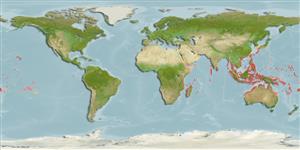Classificação / Names
Common names from other countries
Referência principal
Tamanho / Peso / Idade
Max length : 60.0 cm TL macho/indeterminado; (Ref. 9710); common length : 40.0 cm TL macho/indeterminado; (Ref. 5450); Peso máx. publicado: 8.0 kg (Ref. 37816)
Ambiente
; marinhas; Água doce; estuarina associadas(os) a recifes; catádromos (Ref. 46888); intervalo de profundidade 0 - 3 m (Ref. 86942)
Clima / Intervalo
Tropical, preferred 28°C (Ref. 107945); 35°N - 32°S, 28°E - 135°W
Distribuição
Indo-Pacific: Red Sea south to Transkei, South Africa (Ref. 4393) and east to the Hawaiian and Marquesan islands, north to southern Japan, south to New Caledonia and Norfolk Island (Ref. 8879) and Tuamotu Islands (Ref. 90102).
Países | Áreas FAO | Ecossistemas | Ocorrências | Introduções
Descrição suscinta
Espinhos dorsais (total): 4 - 5; Raios dorsais (total): 8-9; Espinhos anais 3; Raios anais : 8 - 10. Bluish brown or green dorsally; flanks and abdomen silvery; dusky spots on upper row of scales, giving indistinct longitudinal stripes (Ref. 9812). Dorsal and upper lobe of caudal fin with dark-blue tip. Anal, pelvic, and pectoral fins yellow. Pectorals also with dark blue spot dorsally at origin (Ref. 9812). Pectoral-fin axil scale very long.
Status na Lista Vermelha da IUCN (Ref. 115185)
Perigo para os humanos
Harmless
Uso pelos humanos
Pescarias: espécies comerciais
Mais informação
ReferênciasAquaculturaPerfil para aquaculturaEstirpesGenéticaFrequência alélicaHereditariedadeDoençasProcessamentoMass conversion
Ferramentas
Relatórios especiais
Baixar XML
Fontes da internet
Estimates of some properties based on models
Phylogenetic diversity index
PD50 = 0.5312 many relatives (e.g. carps) 0.5 - 2.0 few relatives (e.g. lungfishes)
Nível Trófico
2.3 ±0.14 se; Based on food items.
Resiliência
Médio, tempo mínimo de duplicação da população 1,4 - 4,4 anos (K=0.23-0.28)
Vulnerabilidade
Moderate vulnerability (40 of 100)
Categoria de preço
